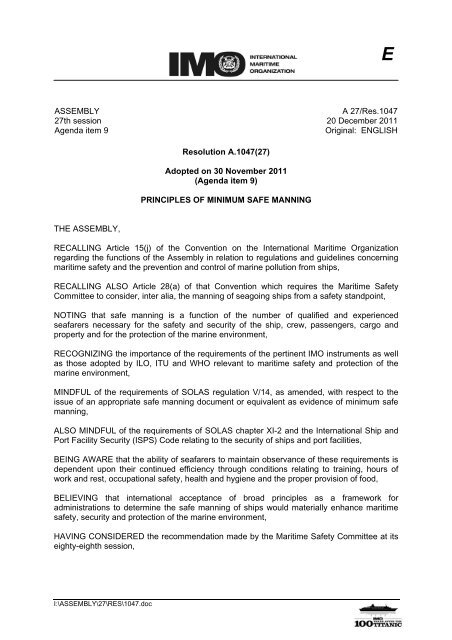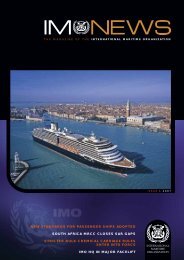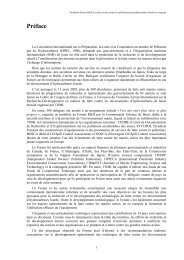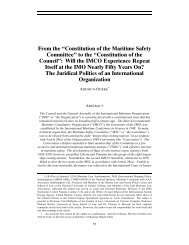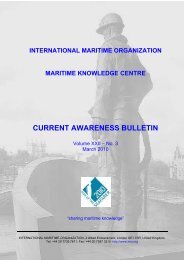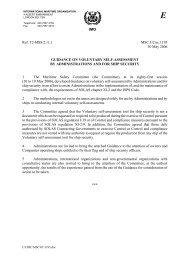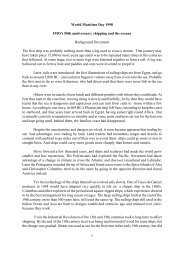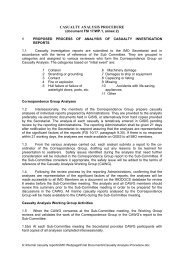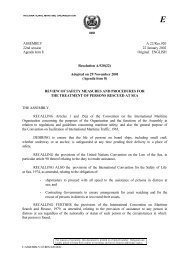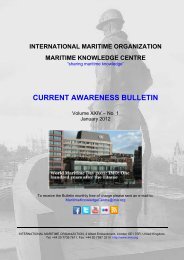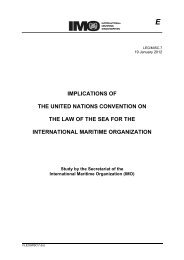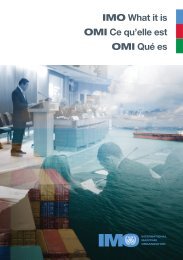1047.doc - IMO
1047.doc - IMO
1047.doc - IMO
Create successful ePaper yourself
Turn your PDF publications into a flip-book with our unique Google optimized e-Paper software.
E<br />
ASSEMBLY<br />
27th session<br />
Agenda item 9<br />
A 27/Res.1047<br />
20 December 2011<br />
Original: ENGLISH<br />
Resolution A.1047(27)<br />
Adopted on 30 November 2011<br />
(Agenda item 9)<br />
PRINCIPLES OF MINIMUM SAFE MANNING<br />
THE ASSEMBLY,<br />
RECALLING Article 15(j) of the Convention on the International Maritime Organization<br />
regarding the functions of the Assembly in relation to regulations and guidelines concerning<br />
maritime safety and the prevention and control of marine pollution from ships,<br />
RECALLING ALSO Article 28(a) of that Convention which requires the Maritime Safety<br />
Committee to consider, inter alia, the manning of seagoing ships from a safety standpoint,<br />
NOTING that safe manning is a function of the number of qualified and experienced<br />
seafarers necessary for the safety and security of the ship, crew, passengers, cargo and<br />
property and for the protection of the marine environment,<br />
RECOGNIZING the importance of the requirements of the pertinent <strong>IMO</strong> instruments as well<br />
as those adopted by ILO, ITU and WHO relevant to maritime safety and protection of the<br />
marine environment,<br />
MINDFUL of the requirements of SOLAS regulation V/14, as amended, with respect to the<br />
issue of an appropriate safe manning document or equivalent as evidence of minimum safe<br />
manning,<br />
ALSO MINDFUL of the requirements of SOLAS chapter XI-2 and the International Ship and<br />
Port Facility Security (ISPS) Code relating to the security of ships and port facilities,<br />
BEING AWARE that the ability of seafarers to maintain observance of these requirements is<br />
dependent upon their continued efficiency through conditions relating to training, hours of<br />
work and rest, occupational safety, health and hygiene and the proper provision of food,<br />
BELIEVING that international acceptance of broad principles as a framework for<br />
administrations to determine the safe manning of ships would materially enhance maritime<br />
safety, security and protection of the marine environment,<br />
HAVING CONSIDERED the recommendation made by the Maritime Safety Committee at its<br />
eighty-eighth session,<br />
I:\ASSEMBLY\27\RES\<strong>1047.doc</strong>
A 27/Res.1047<br />
Page 2<br />
1. ADOPTS the Principles of Minimum Safe Manning, consisting of Guidelines for the<br />
application of principles of safe manning; Guidelines for determination of minimum safe<br />
manning; Responsibilities in the application of principles of minimum safe manning;<br />
Guidance on contents and model form of minimum safe manning document and Framework<br />
for determining minimum safe manning, as set out in Annexes 1, 2, 3, 4 and 5, respectively,<br />
to the present resolution;<br />
2. RECOMMENDS that Governments, in establishing the minimum safe manning<br />
levels for ships flying their country's flag, observe the principles set out in Annex 1 and the<br />
procedures set out in Annex 5 and take into account the guidelines set out in Annexes 2<br />
and 3;<br />
3. URGES Governments to ensure that minimum safe manning documents contain, as<br />
a minimum, the information set out in Annex 4;<br />
4. URGES FURTHER Governments, when exercising port State control functions<br />
under international conventions in force with respect to foreign ships visiting their ports, to<br />
regard compliance with minimum safe manning documents as evidence that such ships are<br />
safely manned;<br />
5. REQUESTS the Maritime Safety Committee to keep this resolution under review<br />
and to amend its provisions as necessary;<br />
6. REVOKES resolutions A.890(21) and A.955(23).<br />
I:\ASSEMBLY\27\RES\<strong>1047.doc</strong>
A 27/Res.1047<br />
Page 3<br />
Annex 1<br />
GUIDELINES FOR THE APPLICATION OF PRINCIPLES OF<br />
MINIMUM SAFE MANNING<br />
1 Introduction<br />
1.1 These Guidelines should be used in applying the principles of minimum safe<br />
manning set out in section 3 to ensure the safe operation of ships to which article III of<br />
the 1978 STCW Convention, as amended, applies, and the security of ships to which<br />
chapter XI-2 of the 1974 SOLAS Convention, as amended, applies, and for the protection of<br />
the marine environment.<br />
1.2 The Administration may retain or adopt arrangements which differ from the<br />
provisions herein recommended and which are especially adapted to technical developments<br />
and to special types of ships and trades. However, at all times the Administration should<br />
satisfy itself that the detailed manning arrangements ensure a degree of safety at least<br />
equivalent to that established by these Guidelines.<br />
2 Objectives<br />
The objectives of these Guidelines are to ensure that a ship is sufficiently, effectively and<br />
efficiently manned to provide safety and security of the ship, safe navigation and operations<br />
at sea, safe operations in port, prevention of human injury or loss of life, the avoidance of<br />
damage to the marine environment and to property, and to ensure the welfare and health of<br />
seafarers through the avoidance of fatigue. These objectives can be achieved through the<br />
following:<br />
.1 adoption of a goal-based approach;<br />
.2 standard procedures for effective implementation; and<br />
.3 effective enforcement.<br />
3 Principles of minimum safe manning<br />
3.1 The following principles should be observed in determining the minimum safe<br />
manning of a ship:<br />
.1 the capability to:<br />
.1 maintain safe navigational, port, engineering and radio watches in<br />
accordance with regulation VIII/2 of the 1978 STCW Convention,<br />
as amended, and also maintain general surveillance of the ship;<br />
.2 moor and unmoor the ship safely;<br />
.3 manage the safety functions of the ship when employed in a<br />
stationary or near-stationary mode at sea;<br />
I:\ASSEMBLY\27\RES\<strong>1047.doc</strong>
A 27/Res.1047<br />
Page 4<br />
.4 perform operations, as appropriate, for the prevention of damage<br />
to the marine environment;<br />
.5 maintain the safety arrangements and the cleanliness of all<br />
accessible spaces to minimize the risk of fire;<br />
.6 provide for medical care on board ship;<br />
.7 ensure safe carriage of cargo during transit;<br />
.8 inspect and maintain, as appropriate, the structural integrity of the<br />
ship; and<br />
.9 operate in accordance with the approved Ship's Security Plan; and<br />
.2 the ability to:<br />
.1 operate all watertight closing arrangements and maintain them in<br />
effective condition, and also deploy a competent damage control<br />
party;<br />
.2 operate all onboard fire-fighting and emergency equipment and<br />
life-saving appliances, carry out such maintenance of this<br />
equipment as is required to be done at sea, and muster and<br />
disembark all persons on board; and<br />
.3 operate the main propulsion and auxiliary machinery including<br />
pollution prevention equipment and maintain them in a safe<br />
condition to enable the ship to overcome the foreseeable perils of<br />
the voyage.<br />
3.2 The following onboard functions, when applicable, should also be taken into<br />
account:<br />
.1 ongoing training requirements for all personnel, including the operation and<br />
use of fire-fighting and emergency equipment, life-saving appliances and<br />
watertight closing arrangements;<br />
.2 specialized training requirements for particular types of ships and in<br />
instances where crew members are engaged in shipboard tasks that cross<br />
departmental boundaries;<br />
.3 provision of proper food and drinking water;<br />
.4 need to undertake emergency duties and responsibilities; and<br />
.5 need to provide training opportunities for entrant seafarers to allow them to<br />
gain the training and experience needed.<br />
I:\ASSEMBLY\27\RES\<strong>1047.doc</strong>
A 27/Res.1047<br />
Page 5<br />
Annex 2<br />
GUIDELINES FOR DETERMINATION OF MINIMUM SAFE MANNING<br />
1.1 The minimum safe manning of a ship should be established taking into account all<br />
relevant factors, including the following:<br />
.1 size and type of ship;<br />
.2 number, size and type of main propulsion units and auxiliaries;<br />
.3 level of ship automation;<br />
.4 construction and equipment of the ship;<br />
.5 method of maintenance used;<br />
.6 cargo to be carried;<br />
.7 frequency of port calls, length and nature of voyages to be undertaken;<br />
.8 trading area(s), waters and operations in which the ship is involved;<br />
.9 extent to which training activities are conducted on board;<br />
.10 degree of shoreside support provided to the ship by the company;<br />
.11 applicable work hour limits and/or rest requirements; and<br />
.12 the provisions of the approved Ship's Security Plan.<br />
1.2 The determination of the minimum safe manning of a ship should be based on<br />
performance of the functions at the appropriate level(s) of responsibility, as specified in the<br />
STCW Code, which include the following:<br />
.1 navigation, comprising the tasks, duties and responsibilities required to:<br />
.1 plan and conduct safe navigation;<br />
.2 maintain a safe navigational watch in accordance with the<br />
requirements of the STCW Code;<br />
.3 manoeuvre and handle the ship in all conditions; and<br />
.4 moor and unmoor the ship safely;<br />
.2 cargo handling and stowage, comprising the tasks, duties and<br />
responsibilities required to plan, monitor and ensure safe loading, stowage,<br />
securing, care during the voyage and unloading of cargo to be carried on<br />
the ship;<br />
I:\ASSEMBLY\27\RES\<strong>1047.doc</strong>
A 27/Res.1047<br />
Page 6<br />
.3 operation of the ship and care for persons on board, comprising the tasks,<br />
duties and responsibilities required to:<br />
.1 maintain the safety and security of all persons on board and keep<br />
life-saving, fire-fighting and other safety systems in operational<br />
condition;<br />
.2 operate and maintain all watertight closing arrangements;<br />
.3 perform operations, as appropriate, to muster and disembark all<br />
persons on board;<br />
.4 perform operations, as appropriate, to ensure protection of the<br />
marine environment;<br />
.5 provide for medical care on board the ship; and<br />
.6 undertake administrative tasks required for the safe operation and<br />
the security of the ship;<br />
.4 marine engineering, comprising the tasks, duties and responsibilities<br />
required to:<br />
.1 operate and monitor the ship's main propulsion and auxiliary<br />
machinery and evaluate the performance of such machinery;<br />
.2 maintain a safe engineering watch in accordance with the<br />
requirements of the STCW Code;<br />
.3 manage and perform fuel and ballast operations; and<br />
.4 maintain safety of the ship's engine equipment, systems and<br />
services;<br />
.5 electrical, electronic and control engineering, comprising the tasks, duties<br />
and responsibilities required to:<br />
.1 operate the ship's electrical and electronic equipment; and<br />
.2 maintain the safety of the ship's electrical and electronic systems;<br />
.6 radiocommunications, comprising the tasks, duties and responsibilities<br />
required to:<br />
.1 transmit and receive information using the radio equipment of the<br />
ship;<br />
.2 maintain a safe radio watch in accordance with the requirements of<br />
the ITU Radio Regulations and the 1974 SOLAS Convention, as<br />
amended; and<br />
.3 provide radio services in emergencies; and<br />
I:\ASSEMBLY\27\RES\<strong>1047.doc</strong>
A 27/Res.1047<br />
Page 7<br />
.7 maintenance and repair, comprising the tasks, duties and responsibilities<br />
required to carry out maintenance and repair work to the ship and its<br />
machinery, equipment and systems, as appropriate to the method of<br />
maintenance and repair used.<br />
1.3 In addition to the factors and functions in paragraphs 1.1 and 1.2, the determination<br />
of the minimum safe manning should also take into account:<br />
.1 the management of the safety, security and protection of the environment<br />
functions of a ship at sea when not under way;<br />
.2 except in ships of limited size, the provision of qualified deck officers to<br />
ensure that it is not necessary for the master to keep regular watches by<br />
adopting a three-watch system;<br />
.3 except in ships of limited propulsion power or operating under provisions for<br />
unattended machinery spaces, the provision of qualified engineer officers to<br />
ensure that it is not necessary for the chief engineer to keep regular<br />
watches by adopting a three-watch system;<br />
.4 the maintenance of applicable occupational health and hygiene standards on<br />
board; and<br />
.5 the provision of proper food and drinking water for all persons on board,<br />
as required.<br />
1.4 In determining the minimum safe manning of a ship, consideration should also be<br />
given to:<br />
.1 the number of qualified and other personnel required to meet peak<br />
workload situations and conditions, with due regard to the number of hours<br />
of shipboard duties and rest periods assigned to seafarers; and<br />
.2 the capability of the master and the ship's complement to coordinate the<br />
activities necessary for the safe operation and for the security of the ship<br />
and for the protection of the marine environment.<br />
I:\ASSEMBLY\27\RES\<strong>1047.doc</strong>
A 27/Res.1047<br />
Page 8<br />
Annex 3<br />
RESPONSIBILITIES IN THE APPLICATION OF PRINCIPLES OF<br />
MINIMUM SAFE MANNING<br />
1 Responsibilities of companies<br />
1.1 The Administration may require the company responsible for the operation of the<br />
ship to prepare and submit its proposal for the minimum safe manning of a ship in<br />
accordance with a form specified by the Administration.<br />
1.2 In preparing a proposal for the minimum safe manning of a ship, the company<br />
should apply the principles, recommendations and guidelines contained in this resolution and<br />
should be required to:<br />
.1 make an assessment of the tasks, duties and responsibilities of the ship's<br />
complement required for its safe operation, for its security, for protection of<br />
the marine environment, and for dealing with emergency situations;<br />
.2 ensure that fitness for duty provisions and record of hours are<br />
implemented;<br />
.3 make an assessment of numbers and grades/capacities in the ship's<br />
complement required for its safe operation, for its security, for protection of<br />
the marine environment, and for dealing with emergency situations;<br />
.4 prepare and submit to the Administration a proposal for the minimum safe<br />
manning based upon the assessment of the numbers and<br />
grades/capacities in the ship's complement required for its safe operation,<br />
for its security and for protection of the marine environment, justifying the<br />
proposal by explaining how the proposed ship's complement will deal with<br />
emergency situations, including the evacuation of passengers, where<br />
necessary;<br />
.5 ensure that the minimum safe manning is adequate at all times and in all<br />
respects, including meeting peak workload situations, conditions and<br />
requirements, and is in accordance with the principles, recommendations<br />
and guidelines contained in this resolution; and<br />
.6 prepare and submit to the Administration a new proposal for the minimum<br />
safe manning of a ship in the case of changes in trading area(s),<br />
construction, machinery, equipment, operation and maintenance or<br />
management of the ship, which may affect the safe manning.<br />
2 Approval by the Administration<br />
2.1 A proposal for the minimum safe manning of a ship submitted by a company to the<br />
Administration should be evaluated by the Administration to ensure that:<br />
.1 the proposed ship's complement contains the number and<br />
grades/capacities of personnel to fulfil the tasks, duties and responsibilities<br />
required for the safe operation of the ship, for its security, for protection of<br />
the marine environment and for dealing with emergency situations; and<br />
I:\ASSEMBLY\27\RES\<strong>1047.doc</strong>
A 27/Res.1047<br />
Page 9<br />
.2 the master, officers and other members of the ship's complement are not<br />
required to work more hours than is safe in relation to the performance of<br />
their duties and the safety of the ship and that the requirements for work<br />
and rest hours, in accordance with applicable national regulations, can be<br />
complied with.<br />
2.2 In applying such principles, Administrations should take proper account of existing<br />
<strong>IMO</strong>, ILO, ITU and WHO instruments in force which deal with:<br />
.1 watchkeeping;<br />
.2 hours of work or rest;<br />
.3 safety management;<br />
.4 certification of seafarers;<br />
.5 training of seafarers;<br />
.6 occupational safety, health and hygiene;<br />
.7 crew accommodation and food;<br />
.8 security; and<br />
.9 radiocommunications.<br />
2.3 The Administration should require a company to amend a proposal for the minimum<br />
safe manning of a ship if, after evaluation of the original proposal submitted by the company,<br />
the Administration is unable to approve the proposed composition of the ship's complement.<br />
2.4 The Administration should only approve a proposal for the minimum safe manning of<br />
a ship and issue accordingly a minimum safe manning document if it is fully satisfied that the<br />
proposed ship's complement is established in accordance with the principles,<br />
recommendations and guidelines contained in this resolution, and is adequate in all respects<br />
for the safe operation and the security of the ship and for the protection of the marine<br />
environment.<br />
2.5 The Administration may withdraw the minimum safe manning document of a ship if<br />
the company fails to submit a new proposal for the ship's minimum safe manning when<br />
changes in trading area(s), construction, machinery, equipment or operation and<br />
maintenance of the ship have taken place which affect the minimum safe manning.<br />
2.6 The Administration should review and may withdraw, as appropriate, the minimum<br />
safe manning document of a ship which persistently fails to be in compliance with rest hours<br />
requirements.<br />
2.7 The Administration should consider the circumstances very carefully before allowing<br />
a minimum safe manning document to contain provisions for less than three qualified officers<br />
in charge of a navigational watch, while taking into account all the principles for establishing<br />
safe manning.<br />
I:\ASSEMBLY\27\RES\<strong>1047.doc</strong>
A 27/Res.1047<br />
Page 10<br />
Annex 4<br />
GUIDANCE ON CONTENTS AND MODEL FORM OF<br />
MINIMUM SAFE MANNING DOCUMENT<br />
1 The following information should be included in the minimum safe manning<br />
document issued by the Administration specifying the minimum safe manning:<br />
.1 a clear statement of the ship's name, port of registry, distinctive number or<br />
letters, <strong>IMO</strong> number, gross tonnage, main propulsion power, type and<br />
trading area, whether or not the machinery space is unattended and<br />
company as defined in the ISM Code;<br />
.2 a table showing the number and grades/capacities of the personnel<br />
required to be carried, together with any special conditions or other<br />
remarks;<br />
.3 a formal statement by the Administration that, in accordance with the<br />
principles and guidelines set out in Annexes 1 and 2, the ship named in the<br />
document is considered to be safely manned if, whenever it proceeds to<br />
sea, it carries not less than the number and grades/capacities of personnel<br />
shown in the document, subject to any special conditions stated therein;<br />
.4 a statement as to any limitations on the validity of the document by<br />
reference to particulars of the individual ship and the nature of service upon<br />
which it is engaged; and<br />
.5 the date of issue and any expiry date of the document together with a<br />
signature for and the seal of the Administration.<br />
2 It is recommended that the minimum safe manning document be drawn up in the<br />
form corresponding to the model given in the appendix to this Annex. If the language used is<br />
not English, the information given should include a translation into English.<br />
I:\ASSEMBLY\27\RES\<strong>1047.doc</strong>
A 27/Res.1047<br />
Page 11<br />
APPENDIX<br />
MODEL FORM OF MINIMUM SAFE MANNING DOCUMENT<br />
MINIMUM SAFE MANNING DOCUMENT<br />
(Official seal)<br />
(State)<br />
Issued under the provisions of regulation V/14 of the<br />
INTERNATIONAL CONVENTION FOR THE SAFETY OF LIFE AT SEA, 1974, as amended<br />
under the authority of the Government of<br />
(Name of the State)<br />
by<br />
(Administration)<br />
Particulars of ship *<br />
Name of ship ..................................................................................................................................<br />
Distinctive number or letters ...........................................................................................................<br />
<strong>IMO</strong> number ...................................................................................................................................<br />
Port of registry ................................................................................................................................<br />
Gross tonnage:<br />
National .......................................................................................................................................<br />
International Tonnage Convention, 1969 ....................................................................................<br />
Main propulsion power (kW) ...........................................................................................................<br />
Type of ship ....................................................................................................................................<br />
Periodically unattended machinery space<br />
yes/no<br />
Operating Company<br />
............................................................................................................................<br />
*<br />
Alternatively the particulars of the ship may be placed horizontally.<br />
I:\ASSEMBLY\27\RES\<strong>1047.doc</strong>
A 27/Res.1047<br />
Page 12<br />
Trading area **<br />
The ship named in this document is considered to be safely manned if, when it proceeds to<br />
sea, it carries not less than the number and grades/capacities of personnel specified in the<br />
table(s) below.<br />
Grade/capacity Certificate (STCW regulation) Number of persons<br />
Special requirements or conditions, if any:<br />
Issued at ............................... on the .................... day of ...............................................<br />
(month and year)<br />
Date of expiry (if any) .....................................................................................................................<br />
(Seal of the Administration)<br />
..........................................................................<br />
(Signature for and on behalf of the<br />
Administration)<br />
**<br />
Where a trading area other than unlimited is shown, a clear description or map of the trading area should<br />
be included in the document.<br />
I:\ASSEMBLY\27\RES\<strong>1047.doc</strong>
A 27/Res.1047<br />
Page 13<br />
Annex 5<br />
FRAMEWORK FOR DETERMINING MINIMUM SAFE MANNING<br />
PREAMBLE<br />
This framework has been developed to assist Administrations and companies in determining<br />
minimum safe manning.<br />
STEPS FOR DETERMINING MINIMUM SAFE MANNING<br />
1 Submission from the company<br />
1.1 Submission of a proposal from the company for minimum safe manning defining the<br />
nature of the operation of the ship.<br />
1.2 Submission needs to take into account the requirements of Annexes 2 and 3 in the<br />
context of the management of the safety, security and protection of the marine environment<br />
functions of a ship.<br />
1.3 The process outlined below should enable companies to achieve greater depth and<br />
insight into the interdependencies and interactions of operational elements that influence the<br />
amounts of crew member workload and, ultimately, the proposed minimum safe manning<br />
level.<br />
Operational functions<br />
1.4 Beginning this process requires the breakdown of the operational elements into<br />
functions. Annex 2 provides guidance on the relevant functions that need to be considered,<br />
however, this list is not exclusive. Each function can then be broken down into a task list that<br />
includes the attributes listed below.<br />
.1 Duration: What is the time required to execute each task? Time in this<br />
case is measurement of total man hours versus the actual duration taken<br />
for task completion, since some tasks can be done in a shorter time by<br />
using multiple individuals.<br />
.2 Frequency: How often is the task performed? This can be categorized<br />
using some form of standard interval (i.e. hourly, daily, weekly, etc.).<br />
.3 Competence: What are the skills, training and qualifications needed to<br />
consistently perform the task properly?<br />
.4 Importance: What is the risk or consequence associated with improper<br />
performance?<br />
I:\ASSEMBLY\27\RES\<strong>1047.doc</strong>
A 27/Res.1047<br />
Page 14<br />
Operational factors<br />
1.5 Once a function is broken down into specific tasks and their attributes, it is then<br />
necessary to determine the specific personnel qualifications, operational policy and<br />
procedures, and infrastructure/technology necessary to perform each task. It is important<br />
to recognize that these elements may increase or decrease manning levels depending<br />
on availability and appropriate procedures and of specific capability enabling technology/<br />
automation.<br />
Task capability<br />
1.6 The information generated in defining the operational factors and functions should<br />
be used to determine how many tasks can be executed by an individual under the possible<br />
range of operational conditions. Critical considerations, while conducting this step, are<br />
human element limitations and relevant standards and regulations. These include sleep and<br />
circadian requirements, physical and mental workload associated with each task, and<br />
exposure limits to shipboard environmental conditions such as noise, temperature and<br />
toxins.<br />
Workload assessments<br />
1.7 Once steps relating to operational functions, operational factors and task capability<br />
have been conducted, the information is then used to determine whether workload will not<br />
exceed the minimum hours of rest and/or work as provided in relevant national and<br />
international regulations. Considerations, while performing this step, include work period<br />
lengths, work schedule designs and whether a single crew member can execute the tasks<br />
set in a specific work period or work period(s) per work day.<br />
2 Evaluation by the Administration<br />
2.1 The Administration should evaluate/approve the submission of the company against<br />
relevant national and international regulatory requirements and guidelines.<br />
2.2 Having evaluated and approved the proposal the Administration should issue a<br />
minimum safe manning document including special requirements and conditions.<br />
3 Maintenance of minimum safe manning document<br />
A company should advise the Administration of any changes that would affect the minimum<br />
safe manning document, and in such circumstances prepare and submit a new proposal<br />
taking into account Annex 3.<br />
4 Compliance monitoring<br />
The Administration should periodically review the minimum safe manning arrangements.<br />
___________<br />
I:\ASSEMBLY\27\RES\<strong>1047.doc</strong>


